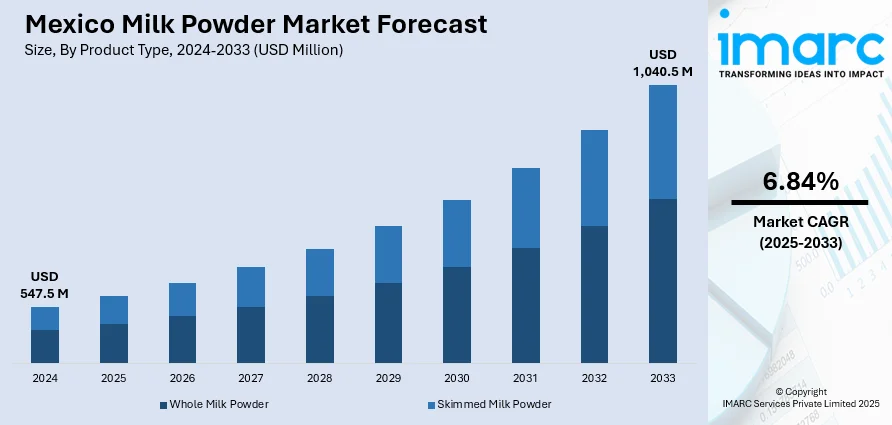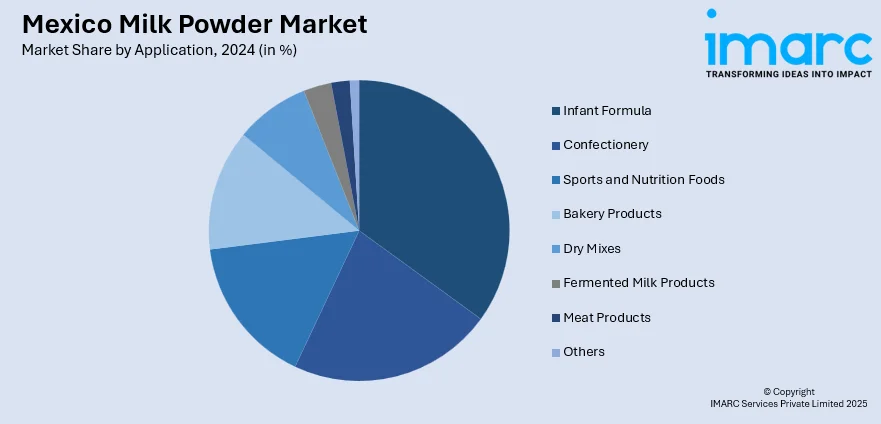
Mexico Milk Powder Market Size, Share, Trends and Forecast by Product Type, Function, Application, and Region, 2025-2033
Mexico Milk Powder Market Overview:
The Mexico milk powder market size reached USD 547.5 Million in 2024. Looking forward, IMARC Group expects the market to reach USD 1,040.5 Million by 2033, exhibiting a growth rate (CAGR) of 6.84% during 2025-2033. Government initiatives to support the dairy industry, along with the rise of e-commerce in Mexico, are fostering milk powder market growth by improving domestic production, enhancing accessibility through online platforms, and providing affordable alternatives, especially in low-income areas, all of while are promoting food security and international partnerships.
|
Report Attribute
|
Key Statistics
|
|---|---|
|
Base Year
|
2024
|
|
Forecast Years
|
2025-2033
|
|
Historical Years
|
2019-2024
|
| Market Size in 2024 | USD 547.5 Million |
| Market Forecast in 2033 | USD 1,040.5 Million |
| Market Growth Rate 2025-2033 | 6.84% |
Mexico Milk Powder Market Trends:
Rise in E-commerce and Online Retail Channels
The growth of e-commerce in Mexico is significantly influencing the milk powder market, with an increasing number of consumers opting for online platforms to buy their groceries and dairy products. Online shopping provides ease, a wide range of products, and attractive prices, making it a favored option for people wanting to purchase milk powder without the inconvenience of going to brick-and-mortar shops. This change is especially noticeable among city dwellers, where digital penetration is growing rapidly. Shoppers can now evaluate brands, check reviews, and discover milk powder choices that might not be found in nearby grocery stores. In addition, major online stores provide a wide selection of milk powder brands, frequently featuring discounts, promotions, and bulk purchase choices that attract budget-minded consumers. Furthermore, creating effective logistics and delivery systems guarantees that consumers in distant locations can obtain milk powder products, thereby broadening the accessibility of the market. The IMARC Group reports that Mexico's e-commerce market size hit USD 47.5 billion in 2024, with projections indicating it will expand to USD 176.6 billion by 2033, reflecting a compound annual growth rate (CAGR) of 14.5% from 2025 to 2033. The swift growth of e-commerce is supporting the milk powder market, as an increasing number of consumers turn to online shopping for dairy items and other household necessities.

Government Support and Dairy Industry Growth
The governing body in Mexico is actively supporting the dairy industry, creating a favorable environment that is indirectly fueling the growth of the milk powder market. Initiatives to strengthen domestic dairy production, improve agricultural practices, and enhance food safety regulations are helping in boosting the availability and affordability of milk powder. As the industry expands, subsidies and support for dairy farmers are leading to more stable milk prices and increased consumer access to milk powder. This is especially important in low-income areas, wherein the affordability of fresh milk can be a challenge, making milk powder a more accessible alternative. The governing authority is also focusing on strengthening food security by promoting nutritional products, which is contributing to a rise in milk powder consumption across various demographics. Furthermore, by fostering international relationships and promoting local industry growth, the government policies are positioning the milk powder market for continued success in Mexico’s dynamic dairy landscape. In 2024, US and Mexican dairy industry leaders met in Chihuahua, Mexico, to renew their commitment to cross-border cooperation. The meeting focused on issues such as dairy trade, consumption growth, and improving productivity in both countries. The partnership aimed to strengthen the dairy sector and address challenges like sustainability and animal welfare.
Mexico Milk Powder Market Segmentation:
IMARC Group provides an analysis of the key trends in each segment of the market, along with forecasts at the regional level for 2025-2033. Our report has categorized the market based on product type, function, and application.
Product Type Insights:
- Whole Milk Powder
- Skimmed Milk Powder
The report has provided a detailed breakup and analysis of the market based on the product type. This includes whole milk powder and skimmed milk powder.
Function Insights:
- Emulsification
- Foaming
- Flavoring
- Thickening
A detailed breakup and analysis of the market based on the function have also been provided in the report. This includes emulsification, foaming, flavoring, and thickening.
Application Insights:

- Infant Formula
- Confectionery
- Sports and Nutrition Foods
- Bakery Products
- Dry Mixes
- Fermented Milk Products
- Meat Products
- Others
The report has provided a detailed breakup and analysis of the market based on the application. This includes infant formula, confectionery, sports and nutrition foods, bakery products, dry mixes, fermented milk products, meat products, and others.
Regional Insights:
- Northern Mexico
- Central Mexico
- Southern Mexico
- Others
The report has also provided a comprehensive analysis of all the major regional markets, which include Northern Mexico, Central Mexico, Southern Mexico, and others.
Competitive Landscape:
The market research report has also provided a comprehensive analysis of the competitive landscape. Competitive analysis such as market structure, key player positioning, top winning strategies, competitive dashboard, and company evaluation quadrant has been covered in the report. Also, detailed profiles of all major companies have been provided.
Mexico Milk Powder Market News:
- In September 2024, ENS launched its high-quality goat milk powders at the FOOD TECH® Summit & Expo 2024 in Mexico on October 2-3. This represented ENS's initial showcase in Latin America, where the firm sought to engage with local distributors and producers. The company concentrated on highlighting the health advantages of its goat milk powders to improve everyday nutrition.
Mexico Milk Powder Market Report Coverage:
| Report Features | Details |
|---|---|
| Base Year of the Analysis | 2024 |
| Historical Period | 2019-2024 |
| Forecast Period | 2025-2033 |
| Units | Million USD |
| Scope of the Report |
Exploration of Historical Trends and Market Outlook, Industry Catalysts and Challenges, Segment-Wise Historical and Future Market Assessment:
|
| Product Types Covered | Whole Milk Powder, Skimmed Milk Powder |
| Functions Covered | Emulsification, Foaming, Flavoring, Thickening |
| Applications Covered | Infant Formula, Confectionery, Sports and Nutrition Foods, Bakery Products, Dry Mixes, Fermented Milk Products, Meat Products, Others |
| Regions Covered | Northern Mexico, Central Mexico, Southern Mexico, Others |
| Customization Scope | 10% Free Customization |
| Post-Sale Analyst Support | 10-12 Weeks |
| Delivery Format | PDF and Excel through Email (We can also provide the editable version of the report in PPT/Word format on special request) |
Key Questions Answered in This Report:
- How has the Mexico milk powder market performed so far and how will it perform in the coming years?
- What is the breakup of the Mexico milk powder market on the basis of product type?
- What is the breakup of the Mexico milk powder market on the basis of function?
- What is the breakup of the Mexico milk powder market on the basis of application?
- What is the breakup of the Mexico milk powder market on the basis of region?
- What are the various stages in the value chain of the Mexico milk powder market?
- What are the key driving factors and challenges in the Mexico milk powder?
- What is the structure of the Mexico milk powder market and who are the key players?
- What is the degree of competition in the Mexico milk powder market?
Key Benefits for Stakeholders:
- IMARC’s industry report offers a comprehensive quantitative analysis of various market segments, historical and current market trends, market forecasts, and dynamics of the Mexico milk powder market from 2019-2033.
- The research report provides the latest information on the market drivers, challenges, and opportunities in the Mexico milk powder market.
- Porter's five forces analysis assist stakeholders in assessing the impact of new entrants, competitive rivalry, supplier power, buyer power, and the threat of substitution. It helps stakeholders to analyze the level of competition within the Mexico milk powder industry and its attractiveness.
- Competitive landscape allows stakeholders to understand their competitive environment and provides an insight into the current positions of key players in the market.
Need more help?
- Speak to our experienced analysts for insights on the current market scenarios.
- Include additional segments and countries to customize the report as per your requirement.
- Gain an unparalleled competitive advantage in your domain by understanding how to utilize the report and positively impacting your operations and revenue.
- For further assistance, please connect with our analysts.
 Request Customization
Request Customization
 Speak to an Analyst
Speak to an Analyst
 Request Brochure
Request Brochure
 Inquire Before Buying
Inquire Before Buying




.webp)




.webp)












